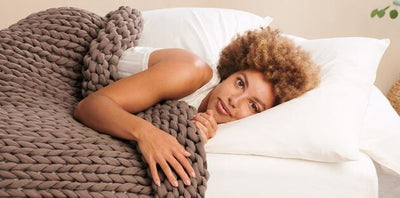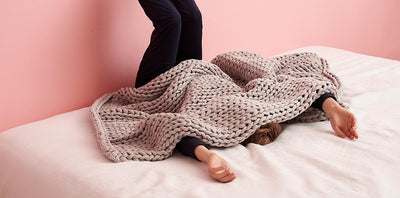What You Need To Know About Making A Weighted Blanket
A DIY weighted blanket might sound simple – you sew pockets into a blanket, add plastic pellets or beads to give it weight, and then add a cover. But there’s more to making a weighted blanket that works and doesn’t leave you feeling too hot and sweaty when using it.

Bearassentials
Making your own weighted blanket starts with sewing pockets into a blanket and then adding a filler like beads or plastic pellets into those pockets to give the blanket weight. Most DIY designs also recommend adding an outer cover over this inner layer.
Common challenges people who make their own weighted blankets face are distributing the weighted materials evenly and finding ways to keep the blanket breathable.
Bearaby’s innovative weighted blankets are knitted with layers of natural, breathable fabric with no beads, pellets, or pockets insight. This type of design distributes the weight evenly for a more effective therapeutic experience, allows for natural airflow, and our sustainable material choices mean the impact on our planet is minimized.
Did you know?
Polyester can take up to 200 years, and plastic up to 500 years to decompose. Wherever you can, be kind to the planet and opt to go plastic-free.
Weighted blankets offer a natural solution to better sleep and reducing anxiety and have surged in popularity over the last few years. Ever wondered if you can make your own weighted blanket?
To reap the optimal health benefits of stress relief and improved sleep quality that weighted blankets can bring, it’s essential to use one that’s thoughtfully designed. This means a blanket that keeps the weight evenly distributed and is breathable so that you don’t wake up sweaty and uncomfortable. Let’s look at the process of making weighted blankets at home in a little more detail.
How To Make Your Own Weighted Blanket: What You’ll Need
Making your own weighted blanket usually requires the following items:
- A durable fabric – ensure you have enough material to make the inner and outer layer of the blanket
- Sewing machine and thread
- A ruler or measuring tape and tailor’s chalk
- A scale
- Fillers to add weight to your blanket

Photo by Mojor Zhu on Unsplash
What Are Weighted Blankets Filled With?
Before we move on to the process of making a DIY weighted blanket, it’s helpful to know what materials can be used to create a heavy blanket. The inner layer of a weighted blanket is usually filled with pockets of sand, plastic pellets, or glass beads to give the blanket its weight. Although these types of fillers are the norm, we innovated the typical manufacturing process with our knitted filler-free weighted blankets. Instead of filling the blankets with artificial materials, we instead layer organic cotton to create our patented weighted yarn. The result is a naturally and evenly weighted blanket that is free of synthetics.
Making A Conventional Weighted Blanket
Now that you know what type of materials are used to fill a weighted blanket let’s move on to how to make one at home.
Start by sewing together the fabric that makes up the inner section as well as the many pockets that will hold the filler. Use the ruler and the chalk to measure equal-sized squares distributed across the entire fabric’s entire surface, and then first sew along the vertical sides of the pockets. Use the scale to measure the amount of filler needed for each pocket, and add the first batches of filler to the pockets. Close off the pockets by sewing the horizontal sides.
Continue this process until you have filled each of the pockets with an even amount of filler. Once completed, insert this weighted inner layer into the outer cover of your blanket.
It can be quite time-consuming to sew the pockets into the blanket, and it’s important to measure and place the pockets evenly throughout the fabric – so while the process of making a blanket isn’t complicated, it can be time-consuming to ensure you create one that is effective in bringing better sleep and reducing stress.
Potential Problems With A Homemade Weighted Blanket
Although a DIY weighted blanket could be a temporary solution, homemade weighted blankets present a few additional problems. The first challenge is to ensure that the blanket you made is evenly distributing the weight, as this is vital to the effectiveness of your weighted blanket. If the fillers inside the blanket tend to bunch up in one place or shift around too much, then your body won’t reap the therapeutic benefits of sleeping under weight. For the science behind how a weighted blanket works to kick in, continuous and evenly distributed full-body pressure is vital.
Another concern is cleaning your blanket: if the outer cover isn't entirely removable, a blanket with beads or pellets isn’t easily machine washable.
It’s also important to keep the planet in mind if you plan to make your own weighted blanket. Will your homemade blanket end up in a landfill at the end of its life cycle? Or is it made of biodegradable materials?

What Sets Bearaby Weighted Blankets Apart
Bearaby’s knitted weighted blankets are made differently than conventional weighted blankets. With our innovative knitted design, we create a sustainable, breathable, medically beneficial product that can help you sleep well at night – and looks good on your bed!
Cotton Napper

Dreamy, buttery softness
Calms body & mind for deeper sleep
Hand-knitted huggable comfort
It's Napper Time
Making weighted blankets the Bearaby way sidesteps many common problems. Our filler-free Nappers distribute weight evenly to ensure you reap the optimal amount of therapeutic benefits, they’re machine washable, breathable, and sustainably made.
Sustainability is something very near to our small business’ heart and that’s why we’ve set out to create products that are as kind to the planet as possible. All our Nappers (and our Napplings) are biodegradable, contain zero artificial fillers, and are packaged without single-use plastics.






